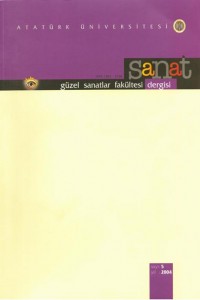Öz
A brief look at the centers where books were copied and iJJuminated in Anatolia prior to the conquest of Istanbul wııı show that the largest and most important place was Konya. Same other clty names than Konya, such as Duvin, Harput, Diyarbakır, Aksarayand Kayserı, have survived up to the present time through the manus<:ripts. Although the Seljuk state was dlssolved In the early 14th century, Konya stiıı preserves Its importance as the capital of both Karamaniı Beylik and Mevlevi Dervish centre. In the 15th century, however. ıııumlnators malntalned their activities in Bursa and Edirne. Towards the end of the century, Istanbul became the most lmportant center of art, whereas Konya came to be an art centre of secondary importance.
A two-volume Koran in KMM No. 18 suggests that books were copied and illuminated In a smaJJ town of Anatolia apart from the big centers In the i 5th century. In the colophon reglster of the work, whlch does not have a title page reglster, it is stated that lt was copied and Illuminated by Ali, the son of Hoşkadem. in Kastamonu in 879 (1474). A comparison between the iIIumination of this work and those of its contemporary manus<:rlpts reveals some similarUles In terms of composition, motif and color. However, the artlstic quality of the work Is not as high as those of the ones wrltten In IstanbuL. lt is Imposslble to determine for whose reading lt was written because the work was devold of the title page register. With the dissolution of the Seljuk state in the Iate 13th century, CandaroguJlan Beyligi relgned in and around Sınop for years but the Beyllk was dominated and conquered by the Ottoman State in the second half of the 15th century. Considering the date when the work was copied. It mlght be thought proper to regard the work as being among the Ottoman book works.
Anahtar Kelimeler
KASTAMONU BELDESINDE 879 (1474) TARIHINDE HOŞKADEMOĞLU ALİ TARAFINDAN İSTİNSAH EDİLİP. TEZHİPLENEN BIR KUR'AN-I KERIM
Öz
istanbul'un fethi öncesinde, Anadolu'da kitap istlnsah edilen ve tezhiplenen merkezlere kısaca bir göz. atıldığında en büyük ve en önemli merkez.ın Konya olduğu görülür. Selçuklu devlet adamlarının, üst düzey yöneticilerinin blllme ve sanata verdikleri destek bilim ve sanat insanlarının saray çevresine toplanmasını sağlamış, Selçuklu sarayları önemli birer kültür ve sanat merkezi olmuşlardır.i Sarayların dışında medreseler de önemli kültür merkezleridir. Bu mekanlarda sadece kitap koleksiyonları oluşturulmamış, yeni eserlerin hazırlanması yolunda da çalışmalar yapllmıştır. 677 (1278) tarihli bir Kur'an-ı Kerim (Dublin, Chester Beatty Library, MS. 1466)l Konya Sadeddin Köpek Medrese'sinde, Hasan bin Cuban bin Abdullah el- Konevi tarafından istinsah edilip, Muhiis bın Abdullah el-Hindi tarafından tezhiplenmiştir. Aynı sanatç yine aynı tarihlerde Mevlana'nın Mesnevi'sinin ilk nüshasının (Konya Mevlana Müzesi, MUzelik Eserler Bölümü no: 51)4 tezhiplerini de yapar. 723( 1323) tarihli diğer bir Mesnevi (Konya Mevlana Müzesi, Müzelik Eserler Bölümü 1177)s ise Sultan Veled'in azadil kölesi Abdullah oğlu Osman tarafından Konya Mevlana Medrese'sinde istinsah edilmiştIr.
Anahtar Kelimeler
Ayrıntılar
| Birincil Dil | Türkçe |
|---|---|
| Bölüm | Makaleler |
| Yazarlar | |
| Yayımlanma Tarihi | 22 Ağustos 2010 |
| Gönderilme Tarihi | 22 Ağustos 2010 |
| Yayımlandığı Sayı | Yıl 2004 Sayı: 5 |

Bu eser Creative Commons Atıf-GayriTicari 4.0 Uluslararası Lisansı ile lisanslanmıştır.


